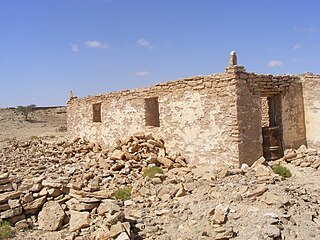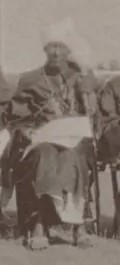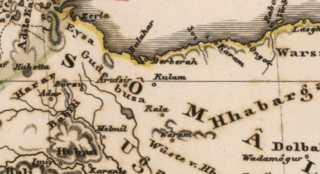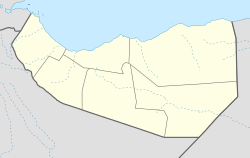The Habar Yoonis alternatively spelled as Habr Yunis is a major clan part of the wider Isaaq clan. As descendants of Ismail bin Sheikh Isaaq, its members form a part of the wider Habar Magaadle confederation which constitutes the largest sub-clan of the Isaaq.
The Arap or Arab clan is a major Northern Somali clan of the wider Isaaq clan family. The Arap predominantly live on the middle and southwest side of Hargeisa and in the Baligubadle district Hawd region) of Somaliland, with its capital Baligubadle being an exclusively Arap territory. The territory of the clan extends to Ethiopia, in the area of Faafan, Gursum and Dhagahle. The Abdalle Arab, a sub-clan of the Arap clan is based in the Togdheer, Sahil. The Celi Arab, a sub-clan of the Arap clan is based in Maroodi Jeex Hargeisa Muuse celi arab living also Bakool South West State of Somalia Rabdhure Elbarde, They also live Fafan Zone Gursum, Somali Sheekh cismaan Arab based in Nogob Zone Jarar Zone regions.

The Eidagalle, is a major Somali clan of the Isaaq clan family. Members of this clan are concentrated in Somaliland and the Somali region. They are the traditional holders of the Isaaq Sultanate since the 18th century. As descendants of Ismail bin Sheikh Isaaq, its members form a part of the Habar Magaadle confederation, and they constitute the largest sub-clan of the Isaaq. They traditionally consist of nomadic pastoralists, merchants and skilled poets.

The Isaaq is a major Somali clan. It is one of the largest Somali clan families in the Horn of Africa, with a large and densely populated traditional territory.
The Habr Garhajis also contemporarily known as the Garhajis is a major clan of the wider Isaaq clan family. They are the traditional holders of the Isaaq Sultanate and Habr Yunis Sultanate since the 18th century. As descendants of Ismail bin Sheikh Isaaq, its members form a part of the Habar Magaadle confederation, and they constitute one of the largest sub-clans of the Isaaq. The Garhajis are divided into two major sub-clans: the Habr Yunis and Eidagale. They are traditionally nomadic pastoralists, merchants and skilled poets.

The history of Somaliland, a country in the eastern Horn of Africa bordered by the Gulf of Aden, and the East African land mass, begins with human habitation tens of thousands of years ago. It includes the civilizations of Punt, the Ottomans, and colonial influences from Europe and the Middle East.

The Harti, (Somali: Harti, Arabic: هرتي, lit. 'strong man'), are a Somali clan that trace their lineage back to SalehAbdi (Harti). They are a sub-clan of the larger Darod clan. Notable sub-clans within Harti include the Majeerteen, Dhulbahante, and the Warsengeli. They predominantly reside in the apex of the Horn of Africa and its surrounding regions. Furthermore, in the southern territories, the clan's settlements span both sides of the Kenya-Somalia border.

The Awal, also contemporarily known as the Habr Awal, Subeer Awal, and alternately known as the Zubeyr Awal is one of the largest subclans of the wider Isaaq clan family, and is further divided into eight sub-clans of whom the two largest and most prominent are the Isamusa and Sa'ad Musa sub-clans. Its members form a part of the Habar Magadle confederation.

The Habr Je'lo, Arabic: هبر جعلو, Full Name: Mūsa ibn ash-Shaykh Isḥāq ibn Aḥmad, historically known as the Habr Toljaala is a major Northern Somali clan of the wider Isaaq family. Its members form the confederation along with the Ibran, Sanbuur and Tolje’lo.

Deria Hassan was a Somali ruler. He was the fourth Grand Sultan of the Isaaq Sultanate and known as a shrewd and wise leader.
Diria Sugulle Ainanshe was a Somali ruler and the 2nd Sultan of the Habr Yunis Sultanate, reigning from the late-eighteenth to the mid-nineteenth century.
Farah Guled was a Somali ruler. He was the second Grand Sultan of the Isaaq Sultanate and also a Hajji having completed pilgrimage to Mecca.
Hassan Farah was a Somali ruler. He was the third Grand Sultan of the Isaaq Sultanate
Guled Abdi was a Somali ruler. He was the first Sultan of the Isaaq Sultanate and his numerous offspring would form the Rer Guled and continue to lead after his death.

The Isaaq Sultanate was a Muslim sultanate that ruled parts of the Horn of Africa in the 18th and 19th centuries. The kingdom spanned the territories of the Isaaq clan in modern-day Somaliland. It was governed by the Rer Guled branch of the Garhajis clan and is the pre-colonial predecessor to the modern Republic of Somaliland.

The Habr Yunis Sultanate was a Somali kingdom that ruled parts of the Horn of Africa during the 18th century. It spanned the territories of the Habr Yunis clan which is part of the wider Isaaq in modern day Somaliland and Ethiopia. The sultanate was governed by the Rer Ainanshe branch of the Habr Yunis clan.

The Reer Caynaashe also spelled Reer Caynaanshe are a royal Somali clan and were the dynastic rulers of the Habr Yunis Sultanate. They divide into 17 major sub-clans that together form the Baha Ainanshe and Rer Sugulle, from the latter descend the rulers of the Habr Yunis Sultanate. They inhabit the Togdheer and Maroodi Jeex regions of Somaliland and the Daroor, Danot and Misraq Gashamo regions of Ethiopia
The Sa'ad Musa or Saad Musa is a northern Somali clan. Its members form a part of the Subeer Awal sub-clan of the Isaaq clan family. The Sa'ad Musa traditionally consists of nomadic pastoralists, coastal people, merchants and farmers. The clan inhabits Somaliland, including Maroodi Jeex, and Sahil as well as Djibouti, the Somali Region of Ethiopia, Kenya and Tanzania.

House of Guled was the ruling house of the Isaaq Sultanate from 1750 to 1884 and is also a subclan in its own right. The family are descendants of the Eidagale sub division of the wider Garhajis and in extension Isaaq clan-family. Although they no longer hold any authority, they are the royal house of Somaliland and are viewed as a favoured symbol in the country. In July 2021, Sultan Mahamed Abdiqadir had a state funeral with nationwide media coverage and was attended by high government officials, including the president of Somaliland; Muse Bihi Abdi and foreign dignitaries.













